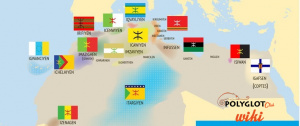Difference between revisions of "Language/Kabyle/Vocabulary/Colors"
m (Quick edit) |
|||
| (2 intermediate revisions by 2 users not shown) | |||
| Line 1: | Line 1: | ||
<div class="pg_page_title">Colors in Kabyle - Writing & Pronunciation</div> | |||
[[File:Berber-languages-polyglot-club.jpg|thumb]] | |||
<blockquote>Initen</blockquote> | <blockquote>Initen</blockquote> | ||
<player>H 1.mp3</player> | <player>H 1.mp3</player> | ||
==Vocabulary== | |||
<blockquote>Amawal</blockquote> | <blockquote>Amawal</blockquote> | ||
Initen (Ini = color/couleur)/The colors/Les couleurs | |||
<player>H 2.mp3</player> | <player>H 2.mp3</player> | ||
*Amellal = White/Blanc (Tamellalt = White/Blanche) plural/pluriel : (Imellalen = White/Blancs , Timellalin = Whites/Blanches) | *Amellal = White/Blanc (Tamellalt = White/Blanche) plural/pluriel : (Imellalen = White/Blancs , Timellalin = Whites/Blanches) | ||
<player>H 3.mp3</player> | <player>H 3.mp3</player> | ||
*Aberkan = Black/Noir (Taberkant = Black/Noire) plural/pluriel : (Iberkanen = Black/Noirs , Tiberkanin = Black/Noires) | *Aberkan = Black/Noir (Taberkant = Black/Noire) plural/pluriel : (Iberkanen = Black/Noirs , Tiberkanin = Black/Noires) | ||
| Line 45: | Line 42: | ||
(Aksum aras = brown skin/peau brune ; Aksum = skin/chair = peau, Aras = Brown/Marron = couleur brune). | (Aksum aras = brown skin/peau brune ; Aksum = skin/chair = peau, Aras = Brown/Marron = couleur brune). | ||
===Tamawt/Remark/Remarque=== | |||
The feminine noun in Kabyle is formed by adding "t" in the beggining and the end of masculine noun/Le féminin en kabyle se forme par l’ajout d’un « t » au début et à la fin du nom masculin. | The feminine noun in Kabyle is formed by adding "t" in the beggining and the end of masculine noun/Le féminin en kabyle se forme par l’ajout d’un « t » au début et à la fin du nom masculin. | ||
==Asisleγ/Practice/Application== | |||
'''Imedyaten/Examples/Exemples :''' | '''Imedyaten/Examples/Exemples :''' | ||
===Singular/Singulier (masculine/masculin, feminine/féminin)=== | |||
==Singular/Singulier (masculine/masculin, feminine/féminin)== | |||
*Γur-i amcic d amellal. | *Γur-i amcic d amellal. | ||
| Line 66: | Line 60: | ||
I saw a white dove/j’ai vu une colombe blanche. (wallaγ = I saw/j’ai vu, titbirt = dove/colombe (pronouned : thithvirth), d = is/est, tamellalt = white/blanche). | I saw a white dove/j’ai vu une colombe blanche. (wallaγ = I saw/j’ai vu, titbirt = dove/colombe (pronouned : thithvirth), d = is/est, tamellalt = white/blanche). | ||
==Plural/Pluriel (masculine/masculin, feminine/féminin)== | ===Plural/Pluriel (masculine/masculin, feminine/féminin)=== | ||
*Ifrax imellalen. | *Ifrax imellalen. | ||
| Line 76: | Line 70: | ||
white doves/colombes blanches. | white doves/colombes blanches. | ||
==Amawal/Vocabulary/Vocabulaire== | |||
*Amalay/Awtem (Awthem) = Masculine/Masculin | *Amalay/Awtem (Awthem) = Masculine/Masculin | ||
| Line 86: | Line 79: | ||
*Titbirt (Tithvirth) = Dove/Colombe | *Titbirt (Tithvirth) = Dove/Colombe | ||
*Unti (pronounced : Ounthi) = Tawtemt (Thawthemt) = Feminine/Féminin | *Unti (pronounced : Ounthi) = Tawtemt (Thawthemt) = Feminine/Féminin | ||
==AUTHOR== | ==AUTHOR== | ||
[https://polyglotclub.com/member/Tansawt Tansawt] | [https://polyglotclub.com/member/Tansawt Tansawt] | ||
==Other Lessons== | |||
* [[Language/Kabyle/Vocabulary/Seasons|Seasons]] | |||
* [[Language/Kabyle/Vocabulary/Clothes|Clothes]] | |||
* [[Language/Kabyle/Vocabulary/Education|Education]] | |||
* [[Language/Kabyle/Vocabulary/Family|Family]] | |||
* [[Language/Kabyle/Vocabulary/Days-of-the-Week|Days of the Week]] | |||
* [[Language/Kabyle/Vocabulary/Months-of-the-Year|Months of the Year]] | |||
* [[Language/Kabyle/Vocabulary/Animals|Animals]] | |||
* [[Language/Kabyle/Vocabulary/Feelings-and-Emotions|Feelings and Emotions]] | |||
* [[Language/Kabyle/Vocabulary/Counting-and-Numbers|Counting and Numbers]] | |||
* [[Language/Kabyle/Vocabulary/Food|Food]] | |||
<span links></span> | |||
Latest revision as of 10:22, 27 March 2023
Initen
Vocabulary[edit | edit source]
Amawal
Initen (Ini = color/couleur)/The colors/Les couleurs
- Amellal = White/Blanc (Tamellalt = White/Blanche) plural/pluriel : (Imellalen = White/Blancs , Timellalin = Whites/Blanches)
- Aberkan = Black/Noir (Taberkant = Black/Noire) plural/pluriel : (Iberkanen = Black/Noirs , Tiberkanin = Black/Noires)
- Awṛaγ = Yellow/Jaune (Tawṛaγt = Yellow/Jaune) plural/pluriel : (Iwṛaγen = Yellow/Jaunes, Tiwṛaγin = Yellow/Jaunes)
- Adal = Green/Vert (Tadalt = Green/Verte) plural/pluriel : (Idalen = Green/Verts, Tidalin = Green/Vertes)
- Azegzaw = Blue/Bleu (Tazegzawt = Blue/Bleue) plural/pluriel : (Izegzawen = Blue/Bleus, Tizegzawin = Blue/Bleues)
- Azegwaγ = Red/Rouge (Tazegwaγt = Red/Rouge) plural/pluriel : (Izegwaγen = Red/Rouges, Tizegwaγin = Red/Rouges)
- Arẓaẓ = Purple/Violet (Tarẓaẓt = Purple/Violette) plural/pluriel : (Irẓaẓen = Purple/Violets, Tirẓaẓin = Purple/Violettes)
- Aranği = Orange/Orange (Taranğit = Orange/Orange) plural/pluriel : (Iranğiyen = Orange/Oranges, Tiranğiyin = Orange/Oranges)
- Axuxi = Pink/Rose (pronounced : Akhoukhi) (Taxuxit = Pink/Rose) plural/pluriel : (Ixuxiyen = Pink/Roses, Tixuxiyin = Pink/Roses)
- Aras = Brown/Brun/Marron ( Tarast = Brown/Brune/Marronne) plural/pluriel : (Irasen = Brown/Bruns/Marrons, Tirasin = Brown/Brunes/Marronnes)
(Aksum aras = brown skin/peau brune ; Aksum = skin/chair = peau, Aras = Brown/Marron = couleur brune).
Tamawt/Remark/Remarque[edit | edit source]
The feminine noun in Kabyle is formed by adding "t" in the beggining and the end of masculine noun/Le féminin en kabyle se forme par l’ajout d’un « t » au début et à la fin du nom masculin.
Asisleγ/Practice/Application[edit | edit source]
Imedyaten/Examples/Exemples :
Singular/Singulier (masculine/masculin, feminine/féminin)[edit | edit source]
- Γur-i amcic d amellal.
I have a white cat/j’ai un chat blanc. (Γur-i = I have/j’ai, amcic = cat/chat (amchich), d = is/est, amellal = white/blanc), on peut dire : j’ai un chat qui est blanc (d’où « d = est »/we can say i have a cat that is white (where "d = is").
- Wallaγ titbirt d tamellalt.
I saw a white dove/j’ai vu une colombe blanche. (wallaγ = I saw/j’ai vu, titbirt = dove/colombe (pronouned : thithvirth), d = is/est, tamellalt = white/blanche).
Plural/Pluriel (masculine/masculin, feminine/féminin)[edit | edit source]
- Ifrax imellalen.
White birds/les oiseaux blancs. (Afrux (Afroukh) = bird/oiseau)
- Titbirin timellalin.
white doves/colombes blanches.
Amawal/Vocabulary/Vocabulaire[edit | edit source]
- Amalay/Awtem (Awthem) = Masculine/Masculin
- Asgwet (prononcé : Asgweth) = Plural/Pluriel
- Asisleγ = Practice/Application
- Asuf = Singular/Singulier
- Itbir (Ithvir) = Pigeon/Pigeon
- Titbirt (Tithvirth) = Dove/Colombe
- Unti (pronounced : Ounthi) = Tawtemt (Thawthemt) = Feminine/Féminin
AUTHOR[edit | edit source]
Other Lessons[edit | edit source]
- Seasons
- Clothes
- Education
- Family
- Days of the Week
- Months of the Year
- Animals
- Feelings and Emotions
- Counting and Numbers
- Food
